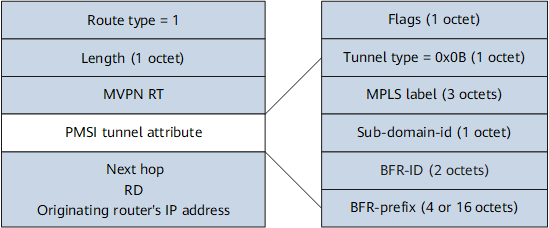NG MVPN over BIER Control Message
In the NG MVPN over BIER scenario, the ingress PE first learns the leaf nodes to which the multicast traffic needs to be sent, and then encapsulates the BitString according to the received MVPN traffic. In an MVPN scenario, the ingress collects information about multicast leaf nodes through BGP-MVPN routes. This process is similar to the process in which MLDP P2MP or RSVP-TE P2MP is used by MVPN to collect information about leaf nodes.
In NG MVPN, the PMSI Tunnel attribute (PTA) carries P-tunnel creation information, which is mainly used to create a P-tunnel. The sender PE encapsulates the PTA in MVPN NLRI Type 1, Type 2, or Type 3 routes and transmits the routes to the receiver PE. The receiver PE encapsulates the PTA in MVPN NLRI Type 4 routes and transmits the routes to the sender PE. Figure 1 shows the format of a route carrying the PTA. Table 1 lists the values of fields in the PTA on the ingress and egress during BIER I-PMSI tunnel establishment.
Field |
Field Value on the Ingress |
Field Value on the Egress |
|---|---|---|
Flags |
1 |
0 |
Tunnel Type |
0x0B |
0x0B |
MPLS Label |
VPN label allocated by the upstream node |
0 |
Sub-domain-id |
Set by the ingress PE based on the service carried over the tunnel |
Sub-domain-id in the BIER tunnel information carried in the PMSI A-D route received from the ingress |
BFR-ID |
BFR-ID configured in the corresponding sub-domain on the ingress PE |
BFR-ID of the egress PE in the corresponding sub-domain |
BFR prefix |
BFR-prefix configured in the corresponding sub-domain on the ingress PE |
BFR-prefix of the egress PE in the corresponding sub-domain |
